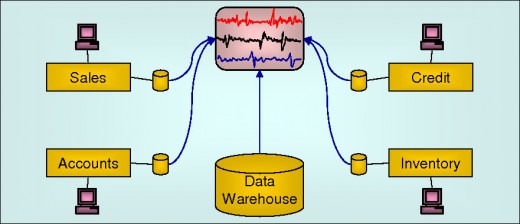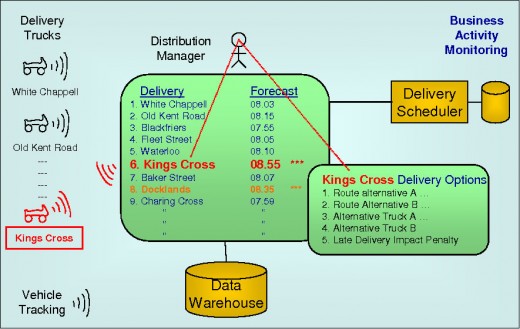Business Activity Monitoring Explained
What is Business Activity Monitoring?
After the 7/11 terrorist attack in New York in 2001, there was considerable investigation into how the US military might better respond to a similar event in the future. Interest spilled over into the commercial world, and companies began looking for ways to respond faster and more effectively to unusual events in their business environments.
How might a company respond faster if the sales of a competitor suddenly increase? What if it suddenly becomes more difficult to manufacture products because the machinery used to create them breaks? How can a company highlight situations like these and have information readily available to either quickly adjust key variables in the business process, or make decisions to hasten changes and protect the company from losses?
These situations are examples of Business Activity Monitoring or BAM.
Until the early 2000s, the closest thing to Business Activity Monitoring was called Event Driven Processing. The idea behind Event Driven Processing is that, instead of responding to requests for action from users, a computer application responds automatically to events as they occur in the environment. An example is automatic stock re-ordering. As part of the sales process, when a low stock situation is detected, an event is triggered and passed to a reordering application that, in turn, orders more stock.
Real Time Activity Monitoring

Event Driven Processing
Converting to an event driven environment not only helps to reduce the level of human involvement, but also means that the business can be run more efficiently. The use of a "just in time" business model is made possible by changing to an event driven environment.
Event Driven Processing allows for supplies to be ordered as-needed as opposed to being bought and stored in advance of sales. Event Driven Processing focuses on automation of the simple, mundane tasks that are traditionally handled by operators, using computer applications developed and maintained internally or by third parties. It allows a reduction (through automation) of a business's running costs because fewer employees are needed, and leaves the remaining staff with more time to concentrate on any exceptional situations that arise from time to time.
What are the limitations of Event Driven Processing?
The September 11th terrorist attack on New York City in 2001 acted as a wake-up call for the US military. Their response was to put in place systems and infrastructure that would allow them to react more quickly and effectively in the event of future attacks. This, in turn, extended into the business world and took on the title of Business Activity Monitoring or BAM. BAM adds a new dimension to Event Driven processing.
Rather than simply automating mundane tasks and reducing running costs however, Business Activity Monitoring focuses on dealing more quickly and effectively with exceptional situations that are encountered in the business environment.
Business Activity Monitoring (BAM)

Examples of Business Activity Monitoring
In a newspaper environment, when a famous person dies, how many extra newspapers should be printed, bearing in mind that the publisher doesn't want to produce a high number of excess or "waste" copies?
Or consider a problem with newspaper deliveries. When a delivery truck breaks down or is involved in an accident, what's the best way of handling it? Should a backup truck from the main depot be dispatched, the delivery route of another vehicle be altered to rendezvous with the breakdown vehicle, a completely different form of transport be organized, or perhaps even cancel the delivery altogether?
How does BAM improve business?
The examples above illustrate situations where Business Activity Monitoring can really help. Business scenarios such as these extend the concept of Event Driven Processing to include the early detection of exceptional circumstances and, often in conjunction with Event Driven Processing, allow for faster and more effective responses to these situations. A business that utilizes BAM becomes more agile and, through its agility and responsiveness, becomes more competitive.
How does BAM typically work?
Business Activity Monitoring works by comparing current, real-time data with historical data and presenting the results graphically, in a way that highlights diversions from the norm. Having highlighted an exception, the BAM solution offers alternative actions to assist with the decision making process. It may even trigger an event that causes a remedial process to kick in automatically.
For our publisher's delivery truck problem the BAM solution might work as follows:
- Data being streamed from the Vehicle Tracking system (there's a vehicle tracking device on every delivery truck) is compared every few minutes with historical tracking data for the delivery routes that are being used. The resulting BAM graphical display highlights any trucks that are running behind schedule and forecasts their delivery times. The supervisor can inform the delivery outlet of impending delays if he deems it appropriate.
- Where a truck has remained stationary for several minutes, the BAM solution highlights this fact and sends an SMS to the driver to ask about the cause of the delay.
- If the driver responds that there's a traffic problem, the BAM solution indicates one or more actions to help alleviate the problem. For example, advise that an alternative route to the delivery outlet is available or recommend the use of another vehicle using an alternate route.
- If the driver doesn't respond (or responds by saying that there's been an accident), the BAM solution assumes that there has been an accident and indicates one or more actions to help alleviate the problem.
Before the advent of Business Activity Monitoring, responding to these problems would have taken longer and been haphazard. Often papers would arrive late (and therefore not get sold) or perhaps not arrive at all. Anyone who works in the newspaper industry is aware of the implications of this, i.e. not simply lost revenue but also penalty rates and the possibility of permanently losing readers to a competitor (who can deliver his newspapers on time).
What data does BAM use to make recommendations?
There are no hard and fast rules about what information a BAM solution can leverage to highlight problems in the business environment. As a general rule though, BAM processing compares streams of current data coming from the core systems of the business with historical data from its data warehouse. This allows for monitoring of the current data "in context." Comparison of the current state with a vast amount of historical data allows a BAM solution to recognize when something untoward is happening or is about to happen.
In our newspaper delivery example, the BAM solution is constantly being drip fed data from a vehicle tracking system. It compares this data with historical data about each route from the data warehouse. The results allow the BAM process to determine that a truck is running behind schedule. Having determined that there might be a problem it then retrieves more information about delivery routes and delivery truck availability from the company's circulation application and makes it ready for graphical presentation.
The end result is a solution that highlights potential problems and supplies additional information that helps the newspaper's distribution manager to resolve the problems more quickly and efficiently.
What should a BAM solution include?
The basic components of a BAM solution include:
- A framework for modeling and expressing business activities.
- A development environment that allows construction of rich graphical presentations for monitoring of business activities. These graphical images are what supervisors and managers see and use.
- Data integration capabilities to map data with activities. The data is retrieved from the company's core systems, its data warehouse, other data stores, and real time feeds from 3rd parties.
- Administrative facilities to manage access rights and content sources.
What should be considered when selecting a BAM tool?
In addition to the fundamental characteristics of a BAM solution described above, when choosing a BAM tool, the following should be considered:
- The variety and quality of graphics. Graphics are a major selling point and should quickly catch the eye when the product is first demonstrated.
- An intuitive what/where/when query paradigm. Ease of use will encourage acceptance of the product by senior managers within an organization.
- Seamless integration with other integration products that the company uses. The BAM solution should tie in well with the company's integration philosophy and technology suite and not require a substantial development effort and cost to achieve.
- Tie-in with the company's Enterprise Portal. Independent of the technology used for implementing a company's Enterprise Portal, a development effort is generally required to integrate the BAM solution with the portal.
- Hooks directly into the messaging infrastructure, including JMS for message-based content delivery. The BAM solution should fit well with any and all message-based integration that is being used.
- Drill-down capabilities to provide in-depth monitoring. Users should be able to view material at whatever level of detail is relevant to their role and not be restricted by the BAM tool.
- Deployable independent of BPM (Business Process Management). Although the combined benefits of a BAM/BPM solution can be substantial, it is important that BAM is not reliant on BPM deployment.
What process should be following to take advantage of this latest style of integration?
As with all major IT development, it's wise to follow a well-established process when implementing a BAM solution. Planning is critical because BAM provides higher order solutions that involve many technologies and user interactions.
The starting point is usually to conduct an IT audit and determine the positioning of BAM in the organization. It should provide an estimate of the developmental effort required to properly support the implementation. These audits include:
- What business data is available for making decisions
- Where that data is located, its format, and how it can be accessed
- What components are already integrated and the integration platform involved
- What interactions exist between components and how is it achieved and monitored
- What feeds the data warehouse and how often is it done.
Armed with an understanding of the general environment in which BAM will operate, the next steps in the implementation process should be:
1. Analyze and define the monitoring content. For each BAM topic the following will need to be defined:
- The business activities being monitored
- Associated events, alerts, and notifications
- Context-related material (typically from the Data Warehouse)
- The relationships between activities, events, alerts, notifications, and context-related material
2. Develop the supporting infrastructure for the implementation of the BAM solutions in relation to the:
- Integration environment
- Data Warehouse
- Core applications
What else is needed to make BAM work?
What potential issues are there? The biggest issue confronting a BAM implementation is its heavy reliance on the underlying infrastructure. Because data is usually fed to a BAM solution from several different sources, and because this involves interfacing with or "talking to" (potentially) a myriad of applications and databases, there are many things that can go wrong.
It is therefore imperative that a business monitors its own IT infrastructure to address any issues "at home" that could affect the quality and reliability of its BAM solution(s).
Is BAM efficient? Are there any performance issues?
BAM is potentially resource hungry. Constant feeds of data from your core systems may have an effect on network performance. The user interface used for BAM is very rich and constantly performs number crunching and refreshing of graphics. For this reason it is common for the user side of BAM to run on powerful stand-alone machines.
How many companies offer BAM solutions?
All of the major integration vendors include a BAM solution as part of their overall integration offering. Business Activity Monitoring is accepted as a key component of an integrated solution and is now considered to be a "maturing" technology.
- Business Activity Monitoring
Description, goals and benefits - EDM and Business Activity Monitoring (BAM)
Building Intelligent Agents using Business Activity Monitoring - Systems Integration Resource Centre
References to integration-related publications. - Systems Integration Made Friendly (Digital Book)
For IT Managers and Developers who would like an overview of Systems Integration but don't need (or want) to get into specifics. Covers: Web Services, Enterprise Service Bus (ESB), Enterprise Portal, SOA, B2B, ERP & Integration Blueprinting. - Bluescribe.com
Specialist provider of Integration Blueprinting services. - BAM Integration Technology Providers
Links to over 20 key players in the Integration market.



